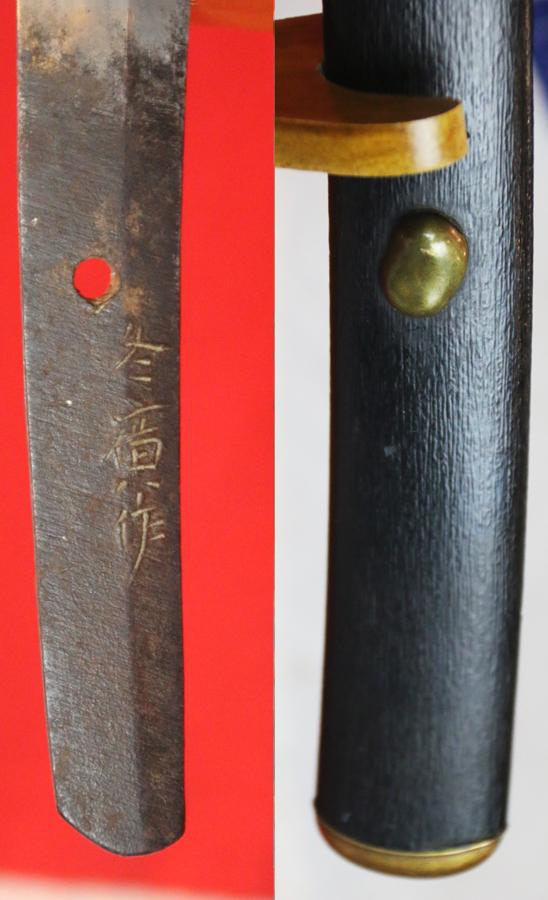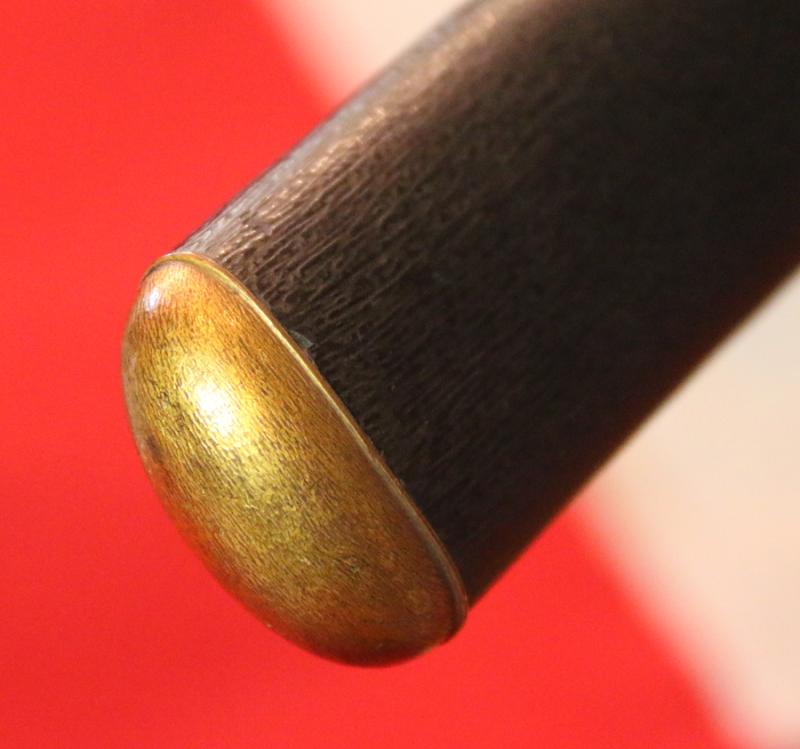A Captivating Shinto Era Wakizashi, Circa 1650, Signed Fuyuhiro. A Wonderful and Elegant Edo Period Sword of Exceptional Sophistication.
A stunning antique shinto wakazashi samurai sword, its blade, fittings and saya have been completely untouched since its arrival in England around 150 years ago. The blade has just been cleaned and conserved and looks fabulous
All original Edo period signed fittings in patinated copper of of superb quality, with a fabulously crafted takebori flying fish on the kashira and an exceptional complimentary fuchi that is signed, and the black tsukaito is wrapped over stunning shakudo and gold menuki, one being a samurai in armour, beneath that is samegawa of extremely rare large inlaid nodules of giant ray skin some over a third of an inch across.
The tsuba is most elegant and understated with intermediate four-line delicate Amidayasuri filemarks or carving representing the halo emanating from Amida Buddha. The blade is bright with a superb midare hamon but best seen in a correct light, in its beautiful black stippled urushi lacquer saya, with a gold sayajiri end cap, and a small, applied, takebori bean form sinchu lower section mount, the saya is complete with a super, signed blade kozuka utility knife, in matching copper, decorated with a takebori figure of Fukurokuju.
In Japan, Fukurokuju is one of the Seven Lucky Gods in Japanese mythology. It has been theorized that he is a Japanese assimilation of the Chinese Three Star Gods (Fu Lu Shou) embodied in one deity. Most related in appearance to the Chinese star god Shou, he is the God of wisdom and longevity. According to some, before attaining divinity, he was a Chinese hermit of the Song Dynasty and a reincarnation of the Taoist Deity, Xuantian Shangdi. It is said that during his human incarnation, he was a sennin; a immortal who could exist without eating food.
Fukurokuju probably originated from an old Chinese tale about a mythical Chinese Taoist hermit sage renowned for performing miracles in the Northern Song period (960–1127). In China, this hermit (also known as Jurōjin) was thought to embody the celestial powers of the south polar star. Fukurokuju was not always included in the earliest representations of the Seven in Japan. He was instead replaced by Kichijōten (goddess of fortune, beauty, and merit). He is now, however, an established member of the Seven Lucky Gods,
The original Edo period urushi lacquer on the saya is in simply excellent condition and shows most elegant simplicity, it reveals within that simplicity the finest craftsmanship and beauty worthy of a master of the art of urushi decor. Japanese lacquer, or urushi, is a transformative and highly prized material that has been refined for over 7000 years.
Cherished for its infinite versatility, urushi is a distinctive art form that has spread across all facets of Japanese culture from the tea ceremony to the saya scabbards of samurai swords
Japanese artists created their own style and perfected the art of decorated lacquerware during the 8th century. Japanese lacquer skills reached its peak as early as the twelfth century, at the end of the Heian period (794-1185). This skill was passed on from father to son and from master to apprentice.
Some provinces of Japan were famous for their contribution to this art: the province of Edo (later Tokyo), for example, produced the most beautiful lacquered pieces from the 17th to the 18th centuries. Lords and shoguns privately employed lacquerers to produce decorated samurai sword saya and also ceremonial and decorative objects for their homes and palaces.
Wakizashi have been in use as far back as the 15th or 16th century. The wakizashi was used as a backup or auxiliary sword; it was also used for close quarters fighting, and also to behead a defeated opponent and sometimes to commit ritual suicide. The wakizashi was one of several short swords available for use by samurai including the yoroi toshi, the chisa-katana and the tanto. The term wakizashi did not originally specify swords of any official blade length and was an abbreviation of "wakizashi no katana" ("sword thrust at one's side"); the term was applied to companion swords of all sizes. It was not until the Edo period in 1638 when the rulers of Japan tried to regulate the types of swords and the social groups which were allowed to wear them that the lengths of katana and wakizashi were officially set.
Code: 24338
5650.00 GBP










